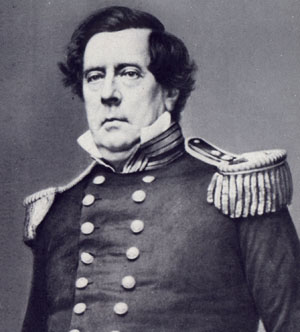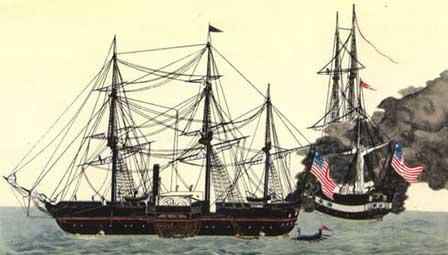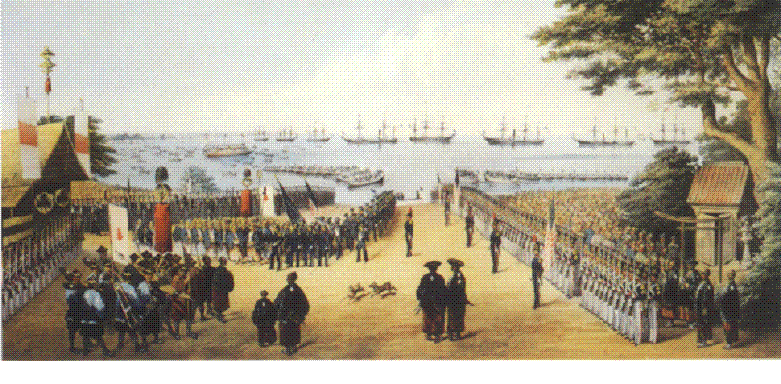Commodore Matthew Perry and the 'Opening' of Japan
As a result of victory in the Mexican-American War and the resulting Mexican Cession, the United States was a much larger country than it began being, and many in the government looked to expand America’s influence offshore as well. One object of attention was Japan. 
American ships had sailed around the world, trading with European and Asian nations. However, America did not trade with Japan; more accurately, Japan did not trade with America, or with most other countries. The U.S. Navy was particularly keen on buying coal from Japan; the demand for coal in Hawaii was already too great. The U.S. sent 27 ships, including three warships, to Japan between 1790 and 1853, and all were turned away by Japanese leaders who were pursuing a policy of strict isolation, reintroduced by the Tokugawa Shogunate: Alone among other nations of the world, the Netherlands had permission to land one ship in Japanese ports every year. The Japanese refusals included ships containing shipwrecked Japanese sailors. The American government wanted to extend its influence politically and economically, hoping that trade routes between America and Japan could be established. The goal was a treaty to be signed by representatives of both countries, and the U.S. government was prepared to use “gunboat diplomacy” if the need arose. One primary point of discussion was to the treatment of shipwrecked soldiers; Americans had been treated particularly badly in Japan.
The American ships landed on the Ryukyu islands on May 17. Marines drilled on the beach for several hours, in full view of Japanese officials who dutifully reported to their government the size of the American fleet and the strength of the American armed forces onboard that fleet. Perry and his fleet continued on to the Ogasawara islands, where the commodore bought some land.
Japanese guard boats surrounded the American ships. One Japanese ship displayed a large sign, written in French, that urged the “invaders” to leave right away. A high-ranking Japanese official was aboard a rowboat that American sailors allowed to dock at an American ship. Perry, however, refused to meet with anyone but the highest-ranking members of the Japanese government. Japan’s leader, Shogun Tokugawa Ieyoshi, was gravely ill and unable to represent his people in this way. He sent two of his most highly ranked officials in his stead, and Perry handed to them a letter from President Millard Fillmore, urging Japan to open trade negotiations with the United States, via a formal treaty. At the same time, Perry and his men went ashore and displayed some more military might; the combination of the onshore military demonstrations, the firing of the cannons, and the clearly visible demonstration of potential firepower aboard the American ships convinced the Japanese government that they would not be able to win a naval battle. Perry left on July 17, for a visit to China, and he made it clear that he wanted an answer to the trade entreaty when he returned in a few months. Not long after the American ships sailed away, the shogun died and the government descended into disarray. Japan also got a visit from a Russian admiral who had pressured Japan to sign a treaty with Russia.
The Americans landed in Yokohama on March 8. Negotiations stretched for three weeks, and then both sides signed what came to be known as the Convention of Kanagawa. Japan agreed to allow American ships to sail in and out of the ports of Hakodate and Shimoda; as well, Shimoda would be the site of an American consulate. With the introduction of trade, each country experienced an influx of money from the other. This resulted in inflation in Japan, and conditions were bad enough to exacerbate an already tenuous political situation, with the ultimate result the fall of the Tokugawa Shogunate and the Meiji Restoration. The treaty proved lucrative for America, however, and for France, Great Britain, the Netherlands, and Russia: All four of those nations signed treaties with Japan as well; this accelerated the downfall of the Japanese government. |
|



 In 1853, Commodore Matthew Perry (brother of hero
In 1853, Commodore Matthew Perry (brother of hero  By the time that Perry and four ships arrived in Edo Bay on July 8, 1853, the Japanese were well aware of the size of the American force. Just to make sure, Perry sailed into the bay, toward the capital, Edo, and stopped at town of Uraga, on which the ships trained their guns. The ships fired blanks from dozens of cannons, an action that Perry later claimed was in celebration of American Independence Day (which was on July 4).
By the time that Perry and four ships arrived in Edo Bay on July 8, 1853, the Japanese were well aware of the size of the American force. Just to make sure, Perry sailed into the bay, toward the capital, Edo, and stopped at town of Uraga, on which the ships trained their guns. The ships fired blanks from dozens of cannons, an action that Perry later claimed was in celebration of American Independence Day (which was on July 4).  Perry returned to Japan on February 13, 1854, at the head of a 10-ship fleet and 1,600-man army. By this time, the leaders of Japan had decided to go ahead with the treaty; however, the two sides could not agree on a place to have an official signing ceremony. In the end, the Japanese built a hall in the tiny village of Yokohama, just for the occasion.
Perry returned to Japan on February 13, 1854, at the head of a 10-ship fleet and 1,600-man army. By this time, the leaders of Japan had decided to go ahead with the treaty; however, the two sides could not agree on a place to have an official signing ceremony. In the end, the Japanese built a hall in the tiny village of Yokohama, just for the occasion. 
